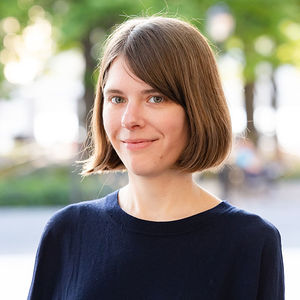Within a Beaux-Arts building on the Upper East Side, Bard Graduate Center alumna Emma Scully recently created a mystical oasis where the past, present, and future met. A door encrusted with ornamented iron bars fittingly led to her pop-up show, Cast Iron—an intersection of industrial making and digital connectivity as well as her graduate studies and work experience.
While studying ceramics at BGC, Scully befriended the manager of the antiques gallery, Mallett, and began working there as a sales manager after graduation. Her interactions with designers of limited-edition collectibles inspired her to build her own collection informed by a conceptual understanding of material culture. After moving to Los Angeles in 2018, she curated shows in her loft displaying sculptural yet functional pieces that alluded to relationships between the digital landscape and the material world. Scully acknowledged that, “The gift of having an education from BGC is that I can think of all these crazy ideas, redefining material design with an academic sensibility. Not many people went into the commercial end of the industry, but I think my time at BGC gave me a really rich foundation for this field. In this moment when I can do my own projects, that has really come into play.”
For her current project, Scully commissioned eight artists of varied backgrounds to send her digitally rendered designs for cast iron pieces and then had these designs produced at O.K. Foundry in Virginia, in business since 1912. Scully coordinated this collaboration to create “a more equitable and environmentally conscious way to run a collectible design gallery.” After paying the artists for their designs, Scully managed their fabrication and the rental of a gallery space, decreasing the financial and environmental costs of international shipping while also giving artists who would have been unable to shoulder the expenses of creating collectible pieces the opportunity to do so. Scully chose to amplify the voices of young, international artists with diverging perspectives and disparate cultural and material backgrounds: The design firm Tellurico from Italy, Faissal El-Malak from Dubai, Charlotte Kingsnorth from the UK, Nel Verbeke from Belgium, and, from the United States, Chen Chen & Kai Williams, Brecht Wright Gander, Bradley L. Bowers, and Ryan Decker.
Why cast iron? Scully explained, “Cast iron for me is a material signifier. It evokes the nineteenth century and a return to the period of making multiples…. The return to cast iron represents a way of making that is more responsible. You have to design for the process.” Designing for the sand-casting process proved to be both a challenge and an educational experience, as only two out of the eight designers had any experience working in this medium, and each designer’s process was as varied as their background. Inspired by the Japanese concept of kintsugi, Chen Chen and Kai Williams fused together rounded panels of cast iron with liquid bronze to create their “Bronze Vein” chair, while Tellurico sent a chair they hand-carved out of wood to create the mold for the final product. Kingsnorth first created a miniature foam version of her mushroom-shaped table that was 3D-scanned, enlarged, and sent as a digital file; El-Malak sent bars of soap carved with images to be cast and stacked in a circular formation inspired by the towers of drying soap found in Nablus, Palestine; and Bowers created a rusted finish for his calabash-shaped planters by soaking them in a kiddie pool. Several of the artists paired cast iron with glass: Verbeke created a bell jar/vase by uniting an alcove-shaped piece of cast iron with an alcove-shaped piece of glass; Wright Gander created an otherworldly lamp by blowing glass into a thorny cast iron cage, and Brecht Wright designed futuristic cast iron legs to support an illuminated neon glass “castle.” All of these pieces were produced using scrap metal.
When displayed together, the pieces had a heavy yet whimsical presence. Standing among them—a gleaming wood-paneled wall with an ornately carved fireplace from 1910 on one side and an iridescent wallpaper designed by Wallpaper Projects and Kin & Company on the other—felt like a time warp. For more information on the designers and their processes, visit @emma_scully_gallery on Instagram.
Mackensie Griffin is a first-year BGC MA Student.




